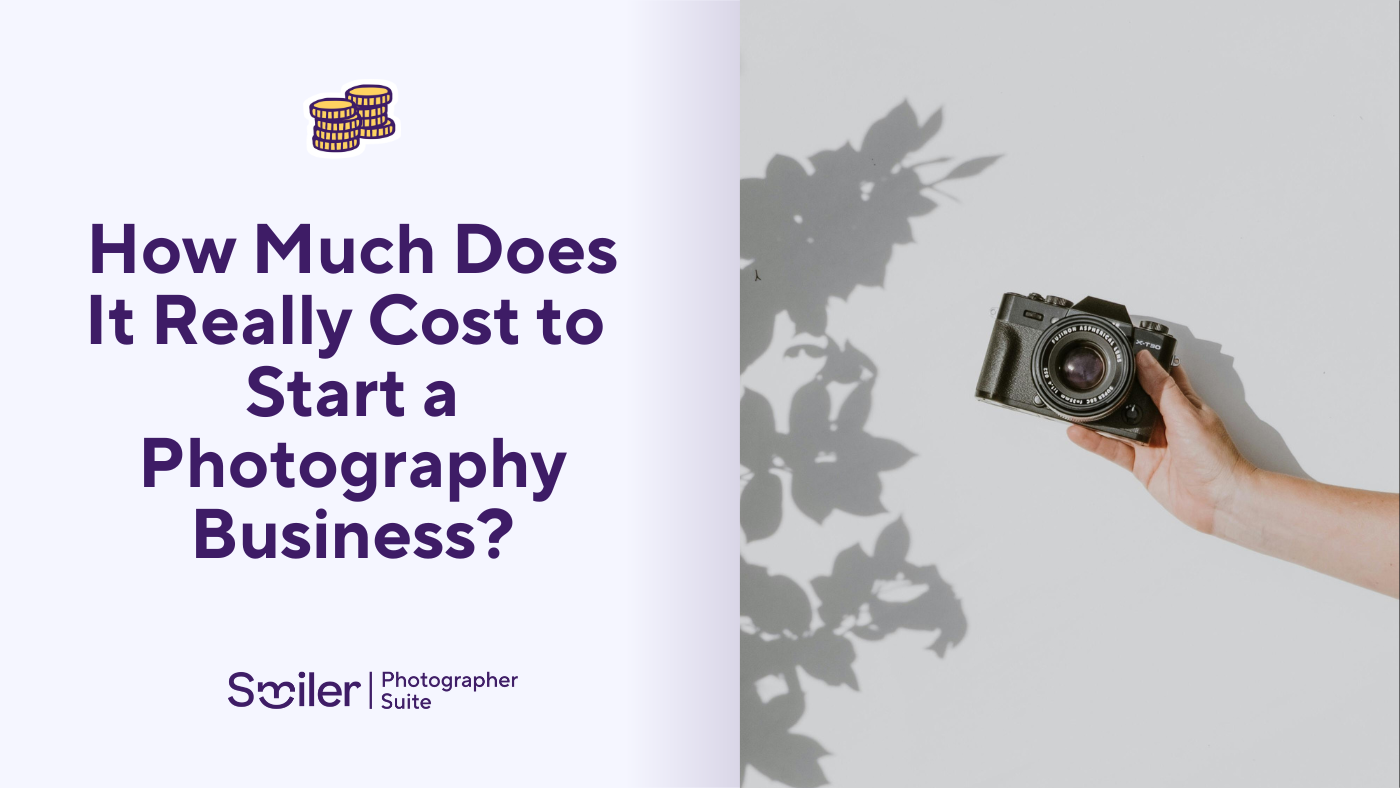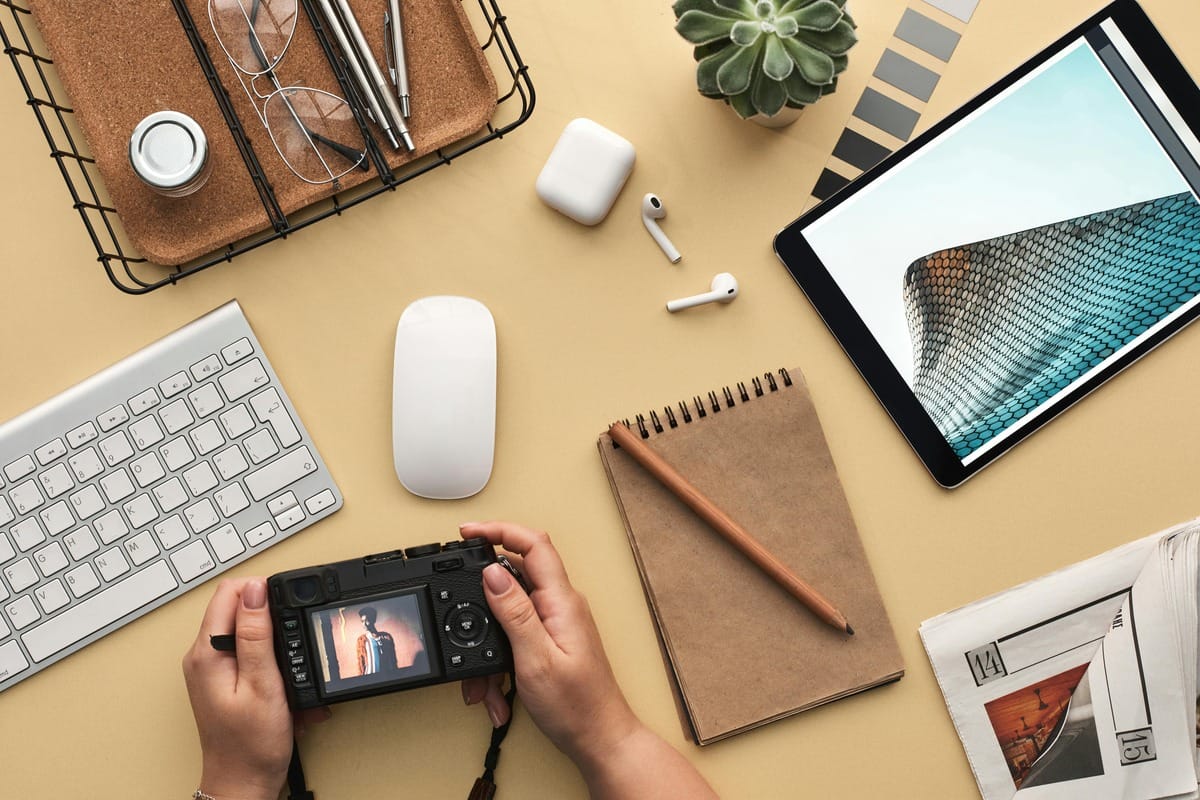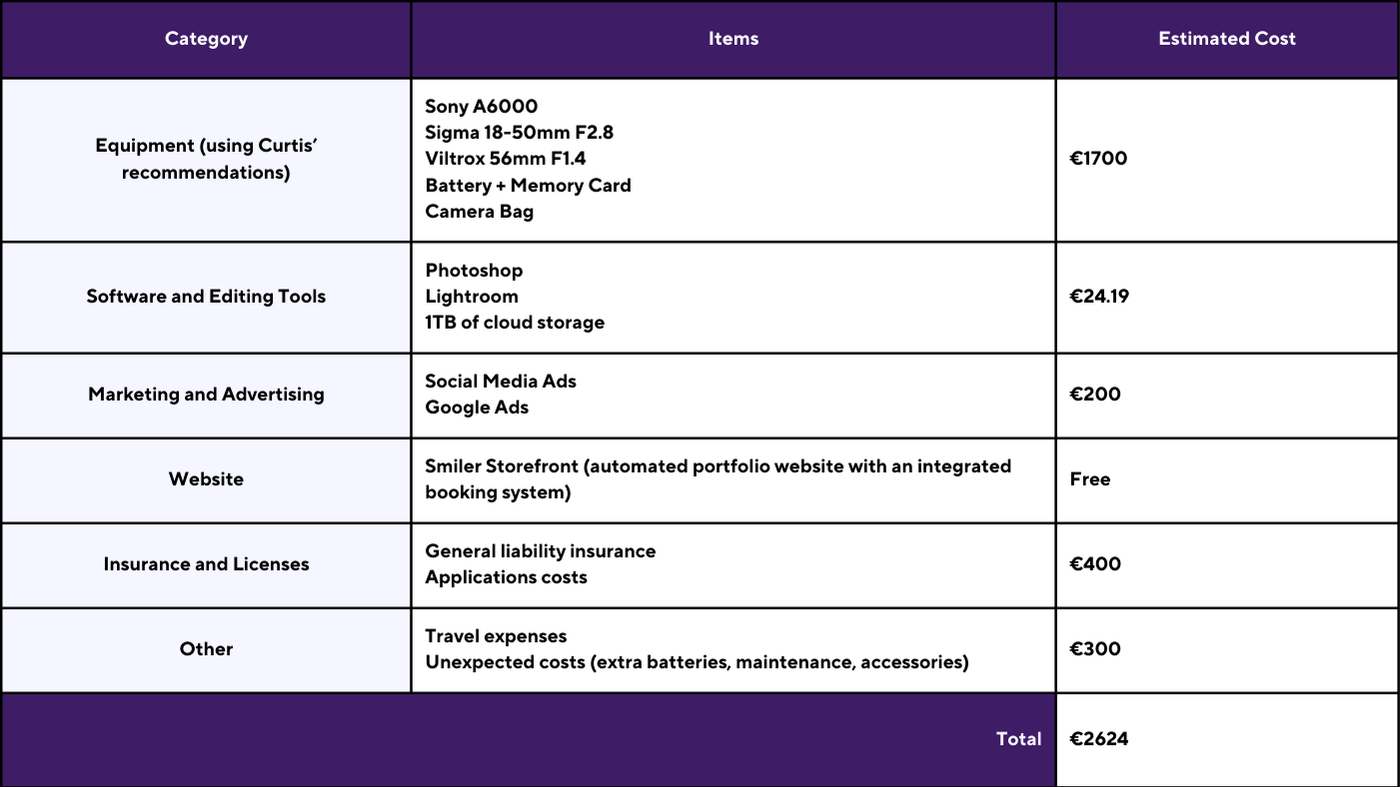How Much Does It Really Cost to Start a Photography Business?

So, you’re thinking about becoming a professional photographer? It’s an exciting step, full of creative possibilities, but we know it can also feel a bit overwhelming when it comes to the practical side—especially the financial aspects.
To build a strong foundation for your professional photography career, it’s essential to create an initial budget and plan for long-term ownership costs. This applies to any photography niche and holds true no matter where you're located. Proper financial planning ensures stability and growth over time.
It can be tough to find all the answers right away, as starting a photography business involves much more than just buying equipment. Until you’ve clearly defined your business goals and evaluate any unique needs or challenges, it's hard to pinpoint financial requirements or potential extra costs.
Since we've been working very closely with both beginner and experienced photographers, we have provided answers to this question countless times. Our aim is to guide photographers at the start of their journey, helping them make informed decisions that lead to long-term success, not just quick wins. In this guide, we'll provide realistic cost estimates based on real-world data and average prices in 2024, to help you build a sustainable photography business.

Please note that the costs discussed in this article, whether for software, equipment, or other expenses, are estimates based on our industry experience and research. The pricing we’ve shared is based on research specific to starting a photography business in the European market, taking into account regional costs and trends. Factors such as VAT (which ranges from 19% to 25% across European countries), subscription models, and one-time payment options may vary between different regions. Our goal is to present a range of realistic figures that can give you a clearer understanding of what to expect when considering the costs of pursuing photography as a career.
How Much Does It Cost to Start a Photography Business?
The costs of running a photography business can vary quite a bit depending on a few important factors—like the type of photography you specialise in which influences your equipment needs, your target audience, and where you’re based. Big cities like Paris, Amsterdam, or NY might offer more opportunities, but they also come with higher costs compared to smaller towns or rural areas. And with technology in photography evolving so quickly, keeping up with the latest equipment and software can feel like a luxury spend, but it’s part of differentiating yourself and staying competitive.
Basic Startup Costs
No matter what type of photography you focus on, there are a few essential investments that every professional photographer needs to think about to set themselves up for success:
Camera Equipment
The most obvious cost in photography is the gear. Depending on what kind of a camera you already own, going pro might require an upgrade. While it's possible to start with entry-level equipment, most professionals opt for full-frame DSLR or mirrorless cameras. Professional-grade camera bodies range from around €1,500 for a good full-frame mirrorless camera to €3,000 for high-end models.
Different niches have specific requirements that certain cameras cater to more effectively. If you want to go into wedding or event photography, you need reliable autofocus, fast shooting speeds, and good low-light performance, making full-frame cameras with high ISO ranges ideal. For product photography, you need to prioritise high resolution for detailed images, so a camera with high megapixels may be necessary. Each niche brings its own set of challenges, and the right camera body will help a photographer handle those specific needs efficiently.
Lenses
Camera lenses come in all shapes and sizes. Once you know your shooting style and the type of photos you want, the lens choice becomes a piece of cake (or at least less of a brain freeze). So let's get to the basics of lenses and share some pro tips from our top-performing photographers to help you make the right choice.
These are the 3 main types of photo lenses that all photographers need to know about to begin their photography career. These are categorised according to their focal length and what they are best for.
The Wide Lens: Any lens with a focal length under 35mm. This is your go-to for sweeping landscapes, dramatic architecture, or anytime you want to fit a whole lot of scene into one shot.
The Standard Lens: Focal lengths between 35mm and 85mm. This is the bread-and-butter of street, travel, and portrait photography. Most photographers agree that for portrait work, 50mm on crop-factor cameras and 85mm on full-frame cameras are ideal—flattering, no face distortion, just pure, undisturbed beauty.
The Telephoto Lens: Focal lengths over 85mm. When you want to capture a lion without becoming lunch or catch your friend’s best mid-air jump at a sports event, this is the lens for you. It’s perfect for wildlife, sports, landscapes, and, of course, portraiture with a little extra drama. Think of it as the lens that likes to keep its distance, but makes sure everything looks epic from afar.
Editing Software
Post-processing is an integral part of modern photography. When choosing editing software as a photographer, it’s important to find tools that match both your creative vision and workflow needs. Popular programs like Adobe Lightroom and Photoshop offer robust tools for colour correction, retouching, and managing large photo libraries. 1TB plan costs around €24/month, offering cloud storage which is ideal if you handle a large number of high-resolution files.
Website & Hosting
Setting up a website and hosting is a crucial step for any photographer looking to showcase their portfolio, attract new clients, and manage their business online.
To set up a website for your photography business, you'll need a domain name (around €10-€20 per year), a website builder like Wix or Squarespace (costing about €10-€30 per month), or hire a custom developer if you want a more personalised site (from €500 upwards). Web hosting options range from affordable shared hosting (€3-€10/month) to more robust dedicated or cloud hosting for higher traffic sites (€30-€100+ per month). You may need to invest in SEO tools or professional marketing services, which can range from €300 to €1,000 per year.
So in total, the estimated annual cost is between €0 and €1,770, depending on your choices for hosting, website builder, and additional features. And if you think €0 is a typo, it’s not! At Smiler, we’ve designed Storefronts to be the most effortless, efficient option for photographers who want a portfolio website that practically runs itself, drives clients to their door, and requires zero set-up or maintenance costs!
With Smiler Photographer Suite's Storefront intuitive interface and smart automation features, you can create a sleek, professional website in just a few clicks. Once it’s live, your Storefront handles the hard work—showcasing your best shots, driving bookings, and building trust with potential clients through features like review collection and display.
Additional Costs
Licensing and Insurance
One of the less-discussed expenses is legal compliance. In most European countries, you’ll need a business license (often around €50 to €150, depending on the country). Professional liability insurance, while not mandatory, is highly recommended. This can cost between €150 and €400 annually, depending on the level of coverage. For instance, if a you accidentally lose important photos, or if clients are unhappy with the final results, they may file a lawsuit. Professional liability insurance covers legal fees, settlements, or judgments, which can be substantial.
Digital Advertising
In photography, you are part of the brand. Clients are not just attracted to beautiful photos; they will gravitate towards your personality and your style. Consider investing in personal branding that showcase your process and passion. It builds trust with your audience and helps you stand out in a crowded market.
You have your social media profile and website ready, now how do you promote it? Digital marketing is key to building a presence! Platforms like Facebook, Instagram, and Pinterest are excellent for photographers to showcase their work.
Social media advertising can be highly cost-effective. The average cost-per-click (CPC) for advertising on Meta hovers around €0.30 to €1.00. A budget of €200-€500 per month can go a long way in reaching your target audience.
Niche-Specific Costs: Studio vs. On-location
Are you planning to work in a studio or on location? If you're considering studio work, you’ll need to factor in the cost of renting or purchasing space. Studio Rental prices vary greatly, but in major European cities, it can range from €200 to €500 per day, or upwards of €1,000 per month if you lease long-term.
If you're an on-location photographer, travel costs for things like transportation and accommodation can add up quickly. In the EU, business mileage is typically reimbursed at about €0.30 per km, depending on the country.
Unexpected Costs: Taxes and VAT
One area that is often overlooked is tax compliance. Many European countries have a Value-Added Tax (VAT), which can be anywhere between 19% to 25%. Understanding VAT regulations for both purchases and client billing is essential. If your annual revenue surpasses a certain threshold (e.g., €85,000 in the UK), you’ll need to register for VAT and handle the extra paperwork, which might involve hiring an accountant—yet another cost, which can be €500-€1,000 annually.
Where can photographers find tax compliance information?
- Government Tax Websites: Each country has its own tax authority, which provides detailed information about tax regulations for businesses, including photographers. For example:
- HMRC: gov.uk covers VAT, income tax, and national insurance for the UK.
- Finanzamt: Their site provides details on VAT, freelance tax laws, and reporting requirements in Germany.
- Dutch Chamber of Commerce (KvK): The KvK offers resources and guides for freelancers starting a business, including tax responsibilities. They also provide workshops and tools for tax registration and compliance.
- Internal Revenue Service (IRS): The IRS provides comprehensive resources for self-employed individuals, including photographers, under the Small Business and Self-Employed Tax Center. Visit the IRS website to access their Small Business Tax Center.
Estimated Budget of Starting a Non-Studio Photography Business
If you've made it this far, you already know that starting a photography business requires more than just a camera and creativity. To help you plan your financial investment, we've put together an estimated cost breakdown for launching a non-studio photography business.
This table highlights key expenses, from equipment and software to marketing and insurance, giving you a better understanding of what to budget for. However, if you're planning to rent a studio, create a home-based studio, or focus on niche services like night photography, your costs will look wildly different.

The numbers above are only estimates and can differ greatly based on your location and the time you're reading this article. Be sure to tailor the budget to your specific circumstances for the most accurate financial planning!
Are You Ready to Make the Leap?
To help you feel confident and ready, we’ve put together the Checklist: Are You Ready to Start a Full-Time Photography Career? This guide walks you through everything you need to consider before making the leap, from budgeting and branding to daily business operations. It’s designed to help you feel prepared for the exciting journey ahead, making sure nothing important slips through the cracks. Make sure to give it a read!

Conclusion & Final Tips
While there’s no universal figure for starting a photography business, many professionals report an initial investment of between €5,000 and €10,000. Mind you, this number includes gear, marketing, and operational costs. If you already have your gear, website, and advertising strategy in place, your expenses will be considerably lower. Remember, every business is unique, so tailor your budget to fit your goals! Here are some tips and lessons learned for beginner photographers:
- Start lean and grow gradually: Don't feel pressured to buy everything at once. Start with essential equipment and expand as your business grows.
- Consider second-hand equipment: Especially for backup gear, buying used can significantly reduce costs without compromising quality.
- Rent before you buy: For specialised equipment you won't use frequently, renting can be more cost-effective.
- Invest in education: Improving your skills can lead to better-paying clients and more efficient work processes.
- Build a financial buffer: The photography business can be seasonal. Save during busy periods to cover slower months.
- Price your services fairly: Download our free eBook now to educate yourself on correct pricing strategies.
- Leverage technology: Tools like Smiler can help streamline your operations, saving time and increase your earning potential significantly.
Up Next:
Dan Higginson on Managing a Wedding Photography Business
Maximise Your Photography Business Value with Alex Hormozi’s Formula

